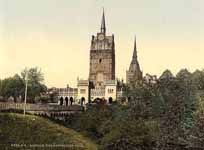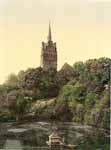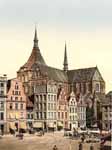.



4, 5, 6,
Rostock
Rostock (German pronunciation: [ˈʁɔstɔk]) is the largest city in the north German state Mecklenburg-Vorpommern. Rostock is located on the Warnow river; the quarter of Warnemünde 12 km north of the city centre lies directly on the coast of the Baltic Sea.
History
Early history
Confirmation of Lübeck law city rights, 1218
In the 11th century Polabian Slavs founded a settlement at the Warnow river called Roztoc (which means broadening of a river); the name Rostock is derived from that designation. The Danish king Valdemar I set the town aflame in 1161.
Afterwards the place was settled by German traders. Initially there were three separate cities:
Altstadt (Old Town) around the Alter Markt (Old Market) with St. Petri (St. Peter's Church),
Mittelstadt (Middle Town) around the Neuer Markt (New Market) with St. Marien (St. Mary's Church) and
Neustadt (New Town) around the Hopfenmarkt (Hop Market, now University Square) with St. Jakobi (St. James's Church, now demolished).
Hanseatic League
The rise of the city began with its membership of the Hanseatic League. In the 14th century it was a powerful seaport town with 12,000 inhabitants and the biggest city of Mecklenburg. Ships for cruising the Baltic Sea were constructed in Rostock. In 1419 one of the oldest universities in Northern Europe, the University of Rostock, was founded.
15th to 18th century
At the end of the 15th century the dukes of Mecklenburg succeeded in enforcing their rule over the town of Rostock, which had until then been only nominally subject to their rule and essentially independent. They took advantage of a riot known as Domfehde, a failed uprising of the impoverished population. Subsequent quarrels with the dukes and persistent plundering led ultimately to a loss of economic and political power.
Rostock 1780-90
The strategic location of Rostock provoked the envy of its rivals. Danes and Swedes occupied the city twice, first during the Thirty Years' War (1618–48) and again from 1700 to 1721. Later, the French, under Napoleon, occupied the town for about a decade until 1813. It was in nearby Lübeck-Ratekau that Blücher, who was actually born in Rostock and who was one of few generals to fight on after the Battle of Jena, surrendered to the French in 1806. This was only after furious street fighting in the Battle of Lübeck, in which he led some of the cavalry charges himself; the exhausted Prussians had, by the time of the surrender, neither food nor ammunition.
19th century
In the first half of the 19th century Rostock regained much of its economic importance, at first due to the wheat trade, and, from the 1850s, to industry, especially to its shipyards. The first propeller-driven steamers in Germany were constructed here.
The city grew in size and population, with new quarters emerging in the south and west of the ancient borders of the city. Two notable developments were added to house the increasing population at around 1900:
Steintor-Vorstadt in the south, stretching from the old city wall to the facilities of the new Lloydbahnhof Railway Station (now Hauptbahnhof). It was designed as a living quarter and consists mostly of large single houses, once inhabited by wealthy citizens.
Kröpeliner-Tor-Vorstadt in the west, designed to house the working population as well as smaller and larger industrial facilities such as Mahn & Ohlerich's Brewery (now Hanseatische Brauerei Rostock). The main shipyard, Neptun was just nearby at the shore of the river.
20th century
Rostock 1910
In the 20th century, important aircraft manufacturing facilities were situated in the city, such as the Arado Flugzeugwerke in Warnemünde and the Heinkel Works with facilities at various places. It was at their facilities in Rostock-Marienehe that the world's first jet plane made its test flights. Aeroplane construction ceased at the end of the Second World War.
Large parts of the central city were destroyed in World War II by Allied bombing in 1942 and 1944. Through reconstruction and subsequent extension, the city became a major industrial centre of the German Democratic Republic with the port being developed as the primary gate to the world. Much of the historic centre has been faithfully rebuilt and much of its historic character restored. This includes several buildings characterised by vertical brick ribs, a style common to the Hanseatic towns.
The destroyed city in 1942
Following the reunification of Germany in 1990, Rostock lost its prior privileged position as the principal overseas port of the former GDR and became one of several German ports, now located in one of the least industrialised regions of reunited Germany. Despite large infrastructure investments, the city's economy declined in the 1990s but is now growing again.
Rostock's population dropped from nearly 260,000 in 1989 to about 200,000 today, primarily due to suburbanisation but also due to emigration to more prosperous western regions of Germany.
Politics
Symbols
Coat of Arms
Motto: Within your walls may it be harmony and happiness
In Rostock's long history, the city carried three different coats of arms known as the Signum, Secretum and Sigillum. The Signum, which can be traced back to 1367, was developed last and is to this day the coat of arms of the city.
The flag depicts a golden griffin on a blue background as well as the colors of the Hanseatic League, silver and red.
The coat of arms can not only be seen on flags, houses and at bus stops, but also on bridges, gullies, fences, ships and restaurants.
Administration
Since the 13th century, the governing body of the city has been the city council (Rat), first consisting of ten, later of 24 aldermen (Ratsherren). The chairman of the city council was the city mayor. In the 19th century there were even three mayors. Since 1925, the head of the city has born the title of Lord Mayor. Having been elected for centuries by the city council, he is now elected directly by the citizens of Rostock, following a reform in 2002.
City Hall
The city parliament (Bürgerschaft) represents the citizens. Representative are elected for five years. The number of representatives is currently 53.
13 Linke
10 SPD
9 CDU
5 Greens
4 FDP
4 FÜR ROSTOCK - pro OB
3 Rostocker Bund
5 others
The city parliament is presided by the Präsident der Bürgerschaft. He heads and prepares the sessions and, together with the Lord Mayor, represents the city.
Roland Methling (Independent), was elected Lord Mayor of Rostock in the first round by 58,2% of the voters on 27 February 2005.
Partner cities
Rostock has signed partnership agreements with the following cities:
Poland Szczecin, Poland, since 1957 Norway Bergen, Norway, since 1965
Finland Turku, Finland, since 1959 Bulgaria Varna, Bulgaria, since 1966
France Dunkirk, France, since 1960 Croatia Rijeka, Croatia, since 1966
Latvia Riga, Latvia, since 1961[2] Germany Bremen, Germany since 1987
Belgium Antwerpen, Belgium, since 1963 China Dalian, People's Republic of China since 1988
Denmark Århus, Denmark, since 1964 United States Raleigh, USA, since 2001
Sweden Gothenburg, Sweden, since 1965
Moreover, Rostock is a member of the international network New Hanse.
Regiopolis Rostock
Geographical position of the Rostock Regiopolis
Rostock is the first German city region that defines itself not only as a city, but as a regiopolis. A regiopolis can be compared with a metropolis, but on a smaller scale. This is a sign for the intraregional cooperation that can be found within the region. A taskforce with different actors such as the hanseatic city of Rostock, the administrative district of Rostock, the Regional Planning Association Mid Mecklenburg/Rostock and the local business organizations is working on the promotion of the concept.[3]
Geography
Rostock is located nearly centrally on Mecklenburg-Vorpommern's Baltic Sea coast. The city is crossed by the Warnow.
The seaside part of Rostock, Rostock-Warnemünde, is about 16 km to the north of the historic city centre. The west and the southeast are the most densely populated parts of town. The overseas port is to the east of Rostock. Rostock stretches 21.6 kilometres from the Baltic Sea to the south and 19.4 km from east to west.
Climate
| Climate data for Rostock | |||||||||||||
|---|---|---|---|---|---|---|---|---|---|---|---|---|---|
| Month | Jan | Feb | Mar | Apr | May | Jun | Jul | Aug | Sep | Oct | Nov | Dec | Year |
| Record high °C (°F) | 11 (52) |
15 (59) |
21 (70) |
26 (79) |
31 (88) |
33 (91) |
34 (93) |
32 (90) |
29 (84) |
22 (72) |
15 (59) |
14 (57) |
34 (93) |
| Average high °C (°F) | 2 (36) |
2 (36) |
7 (45) |
11 (52) |
17 (63) |
20 (68) |
22 (72) |
21 (70) |
18 (64) |
12 (54) |
7 (45) |
3 (37) |
12 (54) |
| Average low °C (°F) | −2 (28) |
−3 (27) |
−1 (30) |
3 (37) |
7 (45) |
10 (50) |
13 (55) |
13 (55) |
9 (48) |
6 (43) |
2 (36) |
−1 (30) |
5 (41) |
| Record low °C (°F) | −18 (0) |
−20 (−4) |
−18 (0) |
−5 (23) |
−3 (27) |
2 (36) |
6 (43) |
5 (41) |
1 (34) |
−5 (23) |
−9 (16) |
−16 (3) |
−20 (−4) |
| Precipitation mm (inches) | 46 (1.81) |
36 (1.42) |
30 (1.18) |
42 (1.65) |
48 (1.89) |
60 (2.36) |
79 (3.11) |
71 (2.8) |
69 (2.72) |
65 (2.56) |
39 (1.54) |
45 (1.77) |
630 (24.8) |
| Source: BBC Weather [4] | |||||||||||||
Main sights
Rostock
Panorama of Rostock from the bank of the Warnow river during the Hanse Sail
Heiligengeisthof (Holy Spirit Courtyard).
One of the most picturesque places in Rostock is the Neuer Markt (New Market Square), with the Town Hall (originally built in the 13th century in Brick Gothic style, but extensively transformed in the 18th century, with the addition of a Baroque facade and a Banqueting Hall. The square also preserved six original, beautifully restored, gable houses from the 15th and 16th centuries. (The rest of the old houses in Hanseatic style that once bordered the square were destroyed in an Allied air-raid in 1942.)
The 15th-century Kerkhofhaus (at Große Wasserstraße, behind the Town Hall) is considered the best preserved brick Gothic house in Rostock.
St. Mary`s Church Marienkirche, on Ziegenmarkt, is an imposing Brick Gothic church. Built in the 13th century, it was enlarged and modified at the end of the 14th century into the present cross-shaped basilica. The huge tower was not completed until the end of the 18th century. Inside there is an astronomical clock built in 1472 by Hans Düringer.
Kröpeliner Straße - the main shopping street.
The main pedestrian precinct is Kröpeliner Straße, that runs east from the Neuer Markt to the 14th-century Kröpeliner Tor, a former town gate. The main buildings of Rostock University lie at Universitätsplatz, near the middle of the street, in front of the lively fountain of zest for life (Brunnen der Lebensfreude).
The Kloster St Katharinen (Convent of St. Catherine), an old Franciscan monastery founded in 1243, and extended several times during the 14th and 15th centuries. Now used as the seat of the Academy of Music and Theatre (HMT-Rostock).
The Brick Gothic Nikolaikirche (St. Nicholas Church), which is the oldest church in Rostock, built in mid-13th century. Heavily damaged during World War II and subsequently restored, the building is now used as an exhibition centre and concert hall, due to its outstanding acoustics.
Some parts of the medieval city wall, with four city gates, have survived to the present day.
Warnemünde
Alexandrinenstraße in Warnemünde.
Speicher (office buildings) at night. Headquarters of AIDA Cruises.
Warnemünde is the seaside part of Rostock and a major attraction of the city. Locals and tourists alike enjoy the maritime flair of old houses, a large beach, a lighthouse and the old fisherman port.
Economy
The economy is strongly influenced by tourism, the University of Rostock and maritime industries (especially shipbuilding) and the service sector. Major companies include:
Aker Warnow Werft, shipyard belonging to Aker Yards
Neptun Werft, shipyard belonging to Meyer Neptun Group
Deutsche Seereederei Rostock, transport, cruises, property and tourism holding
Suzlon,worlds 5th largest wind turbine manufacturers
Nordex, a major producer of wind turbines
Hanseatische Brauerei Rostock, German brewery belonging to the Oetker-Gruppe
Liebherr, manufacturer of cranes
Caterpillar Inc., manufacturer of diesel engines for ships
IKEA
Scandlines, German-Danish ferry operator
Inros Lackner AG, Architects, Engineers, Consulting company
Yara International, supplier of plant nutrients
AIDA Cruises, German company for cruises
Furthermore, Rostock is the seventh-largest port of the Baltic Sea, and among the largest in Germany.
Education
University of Rostock.
Rostock is home to one of the oldest universities in the world. Founded in 1419, the University of Rostock is the third oldest university in Germany in continuous operation, the second oldest in Northern Europe (after St Andrews) and the oldest university in continental northern Europe. It offers graduate and postgraduate programmes in evangelical theology, philosophy and arts, natural sciences and mathematics, law, engineering and naval architecture, agriculture and environmental science, medicine, state, and political and social science, and also maintains a botanical garden (the Botanischer Garten Universität Rostock).
The Academy of Music and Theatre (Hochschule für Musik und Theater) offers graduate degrees in artistic fields. Founded in 1994, the institution combined the former drama school Ernst Busch and the outpost school of the Hanns Eisler Music School Berlin. Today, the school is a member of the Association of Baltic Academies of Music (ABAM), a union of 17 music conservatories at the Baltic Sea and Israel. Unique in Europe is the postgraduate degree in piano duo performance. The school possesses a large opera stage (Katharinensaal) and two chamber music halls. There are concerts every day through the whole year.
Rostock hosts also the Max Planck Institute for Demographic Research, the Leibniz Institute for Catalysis as well as two branches of Fraunhofer Institutes, one for Computer Graphic and one for Large Structures in Production Technology.
Culture
Theater im Stadthafen
Events
The city is home to the annual Hanse Sail festival, during which many large sailing ships and museum vessels are brought out to sea, drawing over 1.5 million visitors.
There is an annual jazz festival taking place in June called Ostsee-Jazz ("Baltic Sea Jazz").
Further events include:
Kurfilmfestival FiSh
Rostocker Kulturwoche
Sommer der Kulturen
Rostocker Hafenfest
Boulevardfest
Warnemünder Woche
Museums and Zoo
Walter Kempowski archives
Rostock Art Gallery (Kunsthalle Rostock)
Museum of Cultural History (Kulturhistorisches Museum)
Stasi Museum (Dokumentations- und Gedenkstätte der Bundesbeauftragten für die Unterlagen des Staatssicherheitsdienstes der ehemaligen Deutschen Demokratischen Republik)
Warnemünde Local History Museum (Heimatmuseum Warnemünde)
Shipbuilding and Shipping Museum (Schiffbau- und Schifffahrtsmuseum)
Rostock Zoo
Walter Kempowski Archive
Music and theatre
Volkstheater Rostock
Norddeutsche Philharmonie
Rostocker Singakademie
Niederdeutsche Bühne Rostock
Compagnie de Comédie
Kleine Komödie Warnemünde
Mechaje
Bühne 602
Festspiele Mecklenburg-Vorpommern
Ostsee Big Band (Jazz)
Sport
DKB-Arena, home ground of Hansa Rostock
Club Sport Founded League Venue Head Coach
F.C. Hansa Rostock Football 1965 2. Bundesliga DKB-Arena Wolfgang Wolf
HC Empor Rostock Team handball 1954 2. Bundesliga Rostocker Stadthalle Maik Handschke
Piranhas Rostock Ice hockey 1990 Oberliga (3rd division) Eishalle Rostock Henry Thom
Transport
Rostock Hauptbahnhof (Central Station)
The cruise ship A'Rosa Blu leaving Rostock in summer 2003
Car
Rostock can be reached by motorway (Autobahn) A 1 from Hamburg via Lübeck on A 20 and by A 19 from Berlin and A 20 from Stettin in Poland.
Public transport
Transit map of Rostock (4 January 2012)
Rostock Hauptbahnhof (Rostock Central Station) offers fast rail connections to Hamburg and Berlin and from there to almost any other European city.
Within the city a wide network of trams, buses and ferries is available. The first privately financed tunnel in Germany crosses the Warnow river and thus connects the eastern part of Rostock with the western part.
Ferry / Ship
Rostock harbour at sunset
Rostock is Germany's largest Baltic port. Rostock is also home to a large ferry port. It is a main base for ferry operators Scandlines, Tallink and TT-Line, which both connect Rostock with major Scandinavian destinations. Furthermore, Rostock receives the highest numbers of cruise tourists in Germany per year.
Ferries leave for
Tallinn, Estonia
Helsinki, Finland
Gedser, Denmark
Trelleborg, Sweden
Plane
The nearest international airports are in Hamburg and Berlin. There are connecting flights via Munich to Rostock Laage Airport. There are also a number of airfields for smaller aircraft, e.g. Purkshof.
Notable people
This is a, naturally, incomplete list of notable people that were born, lived or contributed to the welfare of the City of Rostock:
people who studied or did research in Rostock:
Heinrich Schliemann, finished his PhD
Albert Einstein, received his first Doctor honoris causa in Rostock
Magnus Pegel, mathematician
Fritz Reuter, writer
Rudolf Steiner, founder of Anthroposophy
Uwe Johnson, writer
Arno Esch, politician
Gebhard Leberecht von Blücher, Prussian Generalfeldmarschall
John Brinckman, writer
Walter Kempowski, writer
Ernst Heinkel, aviation pioneer
Walter Hallstein, politician
Joachim Gauck, vicar, first responsible for the BStU
Jan Ullrich, cyclist
Britta Kamrau, swimmer
Paul Walden, scientist
André Greipel, cyclist
Paul Martens, cyclist
References
^ "Bevölkerungsstand der Kreise, Ämter und Gemeinden in Mecklenburg-Vorpommern 31.12.2010" (in German). Statistisches Amt Mecklenburg-Vorpommern. 6 July 2011.
^ "Twin cities of Riga". Riga City Council. Retrieved 2009-07-27.
^ http://www.regiopole-rostock.de/
^ "Average Conditions Rostock, Germany". BBC Weather. Retrieved December 21, 2009.
From Wikipedia, All text is available under the terms of the GNU Free Documentation License

